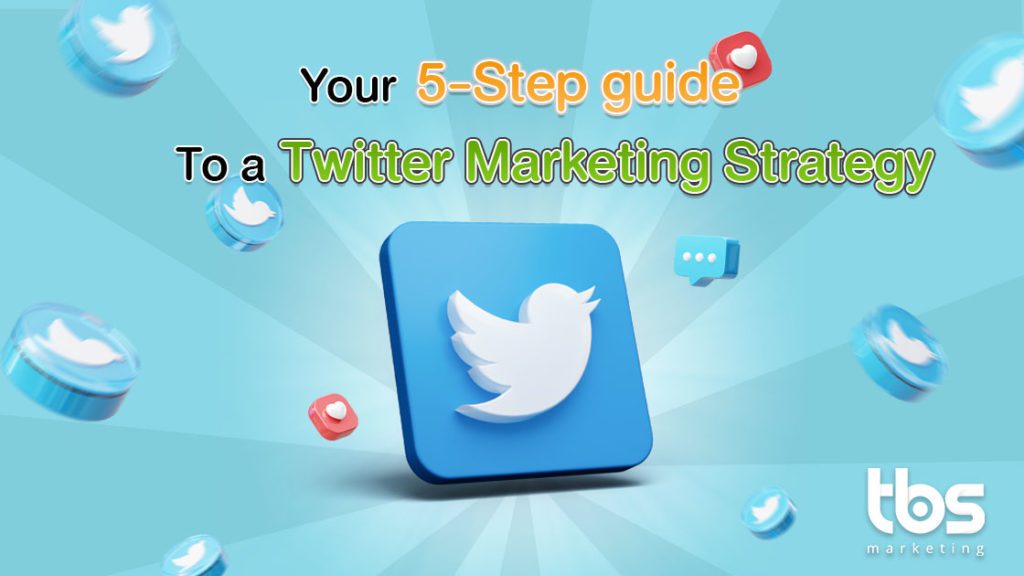
Twitter is a popular social media platform that boasts around 330.0 monthly active users in 2023. This presents an excellent chance for businesses to connect with their desired audience, establish their brand, and drive more traffic to their website.
But to make the most of Twitter, it’s crucial to have a well-planned marketing strategy. This guide will walk you through all the important steps, from defining your goals to analyzing your competition.

What is a Twitter Marketing Strategy?
A Twitter marketing strategy refers to the process of using Twitter to promote a business, build brand awareness, and connect with potential customers. It involves creating and sharing content, engaging with followers, and using Twitter analytics to measure the success of your efforts.
Why use Twitter Marketing for your business?
According to Joe Rice, who leads Twitter’s EMEA Data & Enterprise Solutions, “Twitter is the world’s largest group because, at its core, Twitter is a consumer insights engine. “ (SproutSocial,2020)
It’s worth noting that Twitter’s potential for driving sales should not be overlooked, as statistics indicate that 40% of Twitter users have purchased after discovering a product on the platform.
Additionally, people spend 26% more time watching ads on Twitter compared to other social media platforms, making it an effective avenue for advertising. (Hootsuite,2023)
How to use Twitter for your business?
B2B marketing on Twitter can be a powerful tool for businesses looking to connect with other businesses and build relationships within their industry. When developing a B2B marketing strategy for Twitter, it’s important to understand your target audience and what they’re looking for on the platform.
Here are some tips to get started:

Image Content:
(1.Customise your profile. Add a header image and profile photo that reflects your brand.
2.Add a bio that highlights your unique value proposition.
3.Share valuable content, engage with other users,and use relevant hashtags to reach a wider audience.
4.Track your performance using twitter analytics and make adjustments to your strategy as needed.)
Get Verified
Twitter verification can help businesses establish credibility and build trust with their audience.
To get verified on Twitter, businesses should ensure they meet the eligibility criteria, including having a complete profile, a confirmed email address and phone number, and a history of active and compliant tweeting. They can then submit a verification request to Twitter for review.

Twitter Ads
Twitter offers a range of advertising options for businesses looking to reach a wider audience and drive more traffic to their website. According to Elon Musk’s optimistic view,
“Twitter will have very relevant, useful advertising,”
….“And because it is useful, because it is relevant, there will be a massive increase in revenue, because it is now useful. So I’m very optimistic about the future” (CNN, Business)
Businesses can create promoted tweets, accounts, and trends, and target their ads to specific audiences based on interests, demographics, and behaviour.
Moreover, Promoted tweets are especially a beneficial way to reach the feed of subscribers that are not particularly following you.

Leveraging Different Twitter Ad Formats for Success
Nonetheless, a successful advertising strategy on Twitter involves using various twitter ad formats to appeal to different users.
Promoted Tweets blend in with regular tweets and can help to promote a product or service, while Carousel Ads allow businesses to showcase multiple products or images in one ad.
Video Ads are also effective, as they can demonstrate how a product works, feature customer testimonials or show behind-the-scenes footage of the business.
Etihad Airways saw this campaign as an opportunity to engage in conversations related to The Euros in real time. They ran a promotional campaign on Twitter and applied various targeting tools to reach a wide audience, utilizing a combination of images and videos.
Moving on, a successful Twitter marketing strategy begins with a five-step process. By following these steps, businesses can effectively engage their audiences and gain more traction for their products or services.
1. Defining Your Goals and Target Audience
One of the keys to a successful Twitter marketing strategy is setting clear goals and defining your target audience. By doing so, you can ensure that your efforts are focused and aligned with your business objectives.
- Conduct research: Use Twitter’s analytics tools and other research methods to gather data about your target audience, such as their demographics, interests, and behaviours.
- Analyze audience behaviour and interests: Use this data to analyze your target audience’s behaviour and interests, such as the types of content they engage with and the hashtags they use.
- Segment your audience and create detailed buyer personas to better understand the needs, challenges, and preferences of your target audience.

2. Create Valuable Content
Define your themes: Identify the key themes that you want to cover on Twitter, such as industry news, product updates, or thought leadership.
Use Twitter’s keyword targeting tool: Twitter’s keyword targeting tool allows you to target your tweets to users who have used specific keywords in their tweets or engaged with tweets containing those keywords.
Pro Tip: To effectively manage your Twitter account, determine a realistic posting frequency and use a content management tool like Hootsuite or Buffer to schedule tweets in advance.
Don’t forget to continually monitor performance, which can help ensure a consistent presence and identify resonating content to adjust your strategy accordingly.
3. Make use of the features on Twitter

Twitter lists
Twitter lists are a powerful tool for organizing your followers and staying up-to-date with the latest industry news and trends.
To create a Twitter list, simply click on “Lists” on your profile, then “Create new list,” and start adding Twitter users you want to follow and categorize.
Hosting a Twitter chat
Hosting a Twitter chat can be a great way to engage with your audience, build relationships, and establish yourself as a thought leader in your industry.
To host a Twitter chat, choose a topic and hashtag, invite participants, and plan a series of questions to ask and discuss during the chat.
Twitter moments
Twitter moments are curated collections of tweets around a particular topic or event and can be a powerful way to tell a story and engage your audience.
Twitter Polls
Businesses can use Twitter Polls to gather feedback on their products or services, conduct market research, or generate buzz around an upcoming launch. Polls can also be used to spark conversation and engage with followers, which can help to increase brand awareness and foster a sense of community around the business.
Use popular hashtags

The first step is to identify relevant hashtags for your brand. Research popular hashtags in your industry and check which ones are being used by your target audience. You can also use Twitter’s search function to find relevant hashtags and analyze their popularity and engagement rates.
Branded hashtags
A branded hashtag can help increase brand recognition and make it easier for your audience to find and engage with your content. Make sure your branded hashtag is unique, easy to remember, and relevant to your brand!
Recently, Twitter made its algorithm open-source, resulting in enhanced quality recommendations for users on their “For You” timeline. This significant development may have a notable impact on businesses utilizing Twitter for marketing purposes, as it provides valuable insights into how the platform selects which tweets to display on users’ timelines.
As a result, businesses may leverage this information to optimize their content and achieve better engagement with their target audience.
4. Increase Engagement
Respond promptly to mentions and messages: When someone mentions or messages your brand on Twitter, it’s important to respond as quickly as possible. This shows that you value your followers and are committed to providing excellent customer service.
Retweet and reply to followers: Retweeting and replying to your followers’ tweets is a great way to show that you’re listening and interested in what they have to say.
Interact with your followers: Take the time to interact with your followers on Twitter. This can include asking questions, sharing interesting content, and participating in Twitter chats. By engaging with your audience, you can build a stronger relationship with them and increase their loyalty to your brand.

More importantly, be authentic. When engaging with your audience on Twitter, it’s important to be human and authentic. Avoid using canned responses or automated messages, as these can come across as impersonal and insincere.
Take time to create personalized messages that show your brand’s personality and values. Perhaps throw in some images, videos or GIFS to add a bit of flair and quirk to your brand’s voice.
5. Track your Performance
You can make use of Twitter’s analytics tools to monitor the performance of your account. With these tools, you can track various metrics such as impressions, engagement rates, click-through rates, and follower growth.
Additionally, you can measure the return on investment (ROI) of your Twitter marketing strategies and keep tabs on your conversions and sales.
Audit your Twitter account: Regularly auditing your Twitter account is important for identifying areas where you can improve your performance. This includes tracking hashtag performance, analyzing individual tweet performance, and gaining audience insights.
Businesses can track user actions and sales by setting up conversion tracking pixels and using unique promo codes or URLs in their Twitter campaigns, which enables them to assess their Twitter marketing initiatives and optimize their strategies for improved ROI.
Adjust your Twitter marketing strategy based on insights: Once you have identified areas for improvement through your Twitter analytics, it’s important to adjust your marketing strategy accordingly. This may involve shifting your focus to different types of content or changing the frequency of your tweets.

Analyze your competition on Twitter: Conducting competitive analysis on Twitter can provide valuable insights into what your competitors are doing well and where they may be falling short. This includes analyzing their content strategy, engagement tactics, and overall performance on the platform.
If you need more advice on Twitter or other social media marketing strategies, don’t hesitate to reach out to us today. We specialize in various SMM services whether that may be Instagram or Facebook.
Contact us and Share with us some of your Twitter marketing success stories and let us know what tips you have to offer.
Why not take a moment to check out our Twitter channel?
Check out these 12 powerful examples of b2b companies and how they manage their Twitter profile https://komarketing.com/blog/12-examples-b2b-companies-managing-impactful-twitter-profiles/
References:
